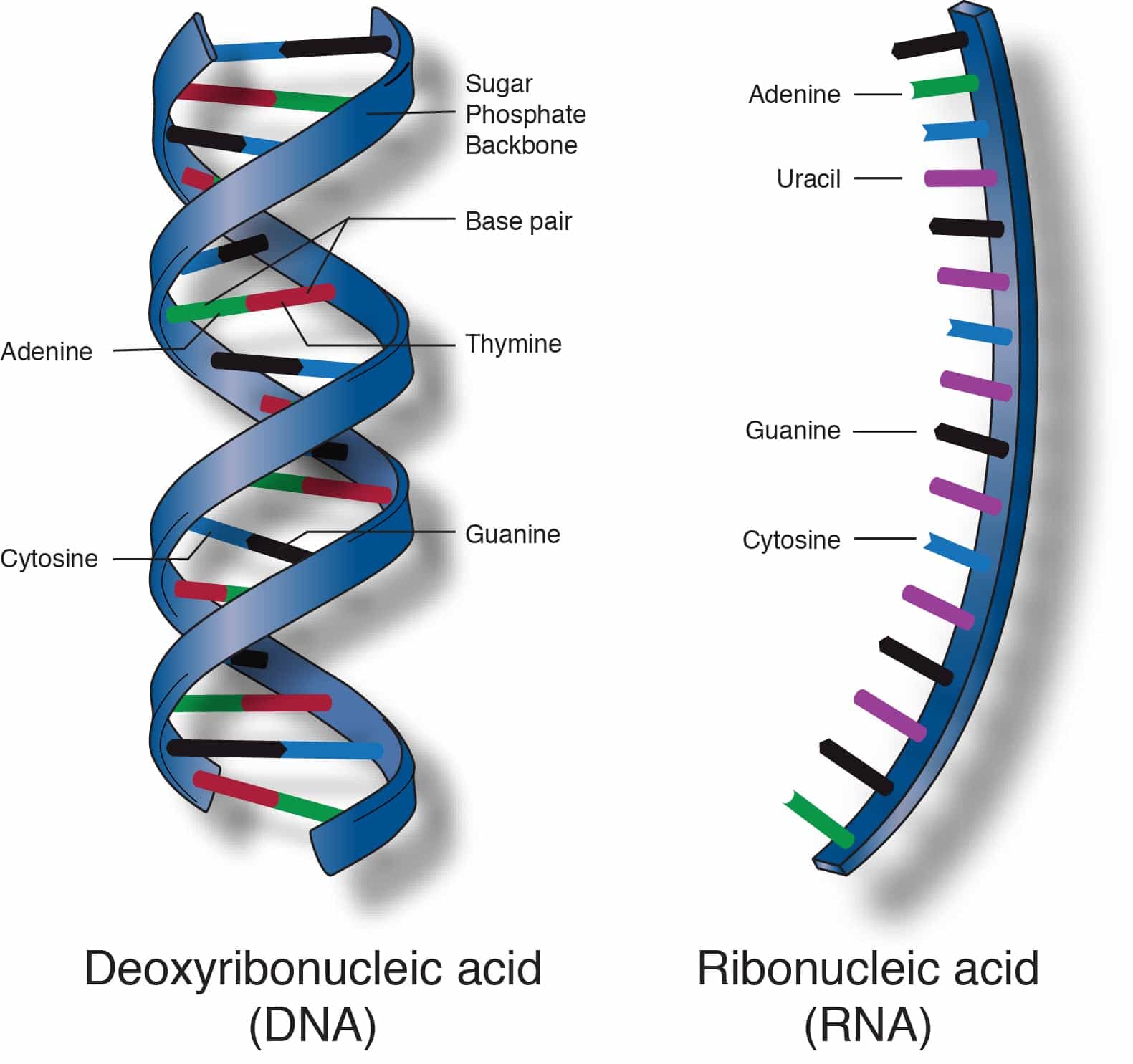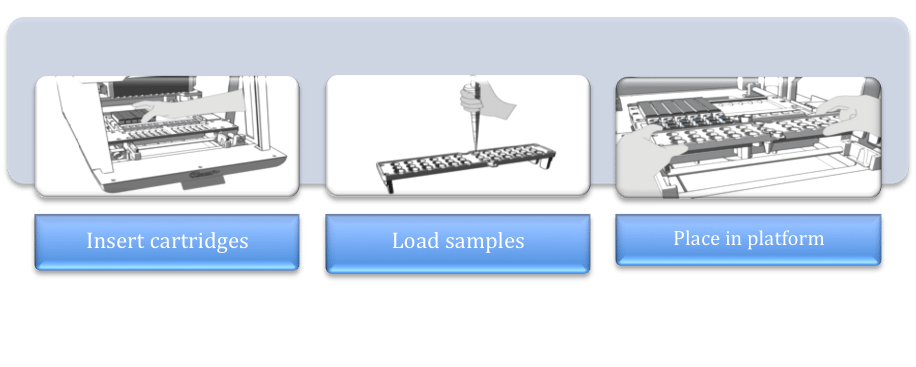Automated DNA Extraction Systems vs Manual Methods - How Automatic Extraction Instruments are Changing Research
Nucleic Acids: The Building Blocks of Life
Nucleic Acids (NA) are naturally occurring macromolecules that are necessary for life to exist. There are two primary forms: deoxyribonucleic acid (DNA) and ribonucleic acid (RNA). DNA is the genetic material present in all living organisms; it passes down hereditary information providing instructions on how to create life-sustaining proteins. RNA is essential for protein synthesis by delivering amino acids that will go on to form proteins. These are depicted in Figure 1.

Figure 1: DNA is a double stranded helix; RNA has a single strand. (National Institute of Health)
Extraction of nucleic acids is a vital part of life science and clinical researches. In molecular biology, NA must be isolated as a starting point for hundreds of downstream applications, such as diagnosis, experimental research, and product development.
Isolated NA should retain high enough quality for use in scientific processes. Extraction has always proved challenging due to various factors. One such factor is the presence of RNase, which promotes the breakdown of RNA and is found commonly in the environment.
Manual Nucleic Acid Extraction: Laborious and Time-Consuming Methodology
There are many commonly used manual NA extractions, all of which are heavily reliant on the use of multiple chemical compounds. The result is a process that is both time-intensive and requires human intervention for every step.
The general extraction method consists of four components:
- Cell lysis to disrupt cells/tissues
- Denature nucleoprotein complexes
- Inactivation of RNA/DNA nucleases
- Avoidance of contamination
One combination of chemicals to separate and extract NA uses guanidinium thiocyanate, phenol, chloroform, and ethanol to remove the impurities of proteins and salt from NA. This adds multiple separation and purification steps to the overall process.
Alkaline lysis can be used to isolate plasmid DNA. This works well with bacterial cultural, such as strains of E. Coli, and uses Sodium Dodecyl Sulfate (SDS) to cause alkaline denaturation of DNA by coating it with the sulfate. Plasmid DNA is then recovered after centrifugation.
For plant extraction, samples are first frozen using liquid nitrogen, then ground to break down the cell wall and allow access to NA without enzymes and chemical activation. Cetyltrimethylammonium bromide (CTAB) precipitates NA, making it useful for the purification process.
While there are several more methods, the common overall usage of conventional manual NA extraction methods is too difficult to use on a regular basis. Being an integral part of clinical research, extraction needed to be simplified. This led to the development of solid-phase nucleic acid purification, which was available as commercial extraction kits in the market. These methods took the first step toward automation by using spin columns or centrifuges. This resulted in a quicker NA extraction process, involving 4 major steps:
- Cell lysis to disrupt cells/tissues
- Nucleic acid absorption
- Washing while avoiding contamination
- Elution
In this semi-automated method, different substances are used for NA purification. Most commonly used are silica matrices, glass particles, diatomaceous Earth, magnetic beads, and anion-exchange resin. One such method is displayed in Figure 2 below. However, even this process of extraction often follows a complex series of steps, requiring much human work for a lesser yield. A system was needed to aid in NA extraction for settings that go through hundreds of samples daily while decreasing human intervention and contamination.

Figure 2: Using premade kits with magnetic beads simplifies the process.
Automated Nucleic Acid Extraction: Simplicity and Convenience
As technology and demand both trend upward, it’s becoming increasingly apparent that automation in labs is the next step in biotechnical research. Automated extraction systems tend to be specifically designed instruments that help simplify and increase output of nucleic acid extraction. Not only do automated machines decrease working time and labor costs needed, it also increases safety, quality, and reliably high yield.
In order to compete with manual extraction, automated systems need to meet several requirements, such as reproducible results, minimal cross-contamination, ease of use, decreased hands-on human intervention, and high quality output for downstream testing.
There are three primary steps in using an automated system:
- Add reagents to liquid samples
- Place cartridges used by the kit in machine
- Start process
Automated instruments tend to utilize the same kits used in solid-phase nucleic acid extraction, but drastically reduce the time and effort required to complete the process. Compared to prior manual extraction methods, it is apparent that automation systems easily meet the requirements to compare against and surpass manual NA extraction.
AnaPrep: Automated Nucleic Acid Preparation System
BioChain’s AnaPrep extraction system uses a magnetic-bead based system to extract the highest quality and yield of nucleic acids. The system is designed to be as simple as possible, processing up to 12 samples at the same time. Reagent kits are prefilled and disposable, making the process user-friendly and economical to avoid wasting product not used.
AnaPrep’s quality and quantity of extracted DNA reliably demonstrates extractions that are similar or better than manual kits. Compared to other automated systems in independent lab tests, AnaPrep has consistently outperformed competitors’ automated systems in yield by micrograms, and quality of extracted DNA containing longer sized DNA fragments. Table 1 depicts results of AnaPrep’s DNA extraction yield compared to Company P:
[table id=16 /]
Figure 3: The process is made easier by premade reagent kits.
The kit comes with a barcode sheet that contains kit-specific protocols, which the LCD screen displays: protocol name, sample volume, and elution volume. Simply scan the correct barcode, and press enter, as shown in Figure 4. The selected protocol will begin to run automatically. The extraction takes 45 to 75 minutes, depending on the protocol being used, and beeps to indicate completion. The elute tubes will contain extracted NA that is ready for downstream applications.

Figure 4: Reagent kit boxes come with their own protocol barcode sheets.
The AnaPrep system reduces contamination using a unidirectional autosampler, as well as built-in UV lamps. The polygon-shaped reaction chamber also eliminates magnetic bead residue. The kits being offered are versatile, as various samples such as cell lines, blood, tissues, urine, and more may be used. See more details on the system in Video 1.
Video 1: The AnaPrep System makes it easy and convenient to extract nucleic acids.
Find reagents and kits to use with AnaPrep!
Discover more on the AnaPrep System here!

